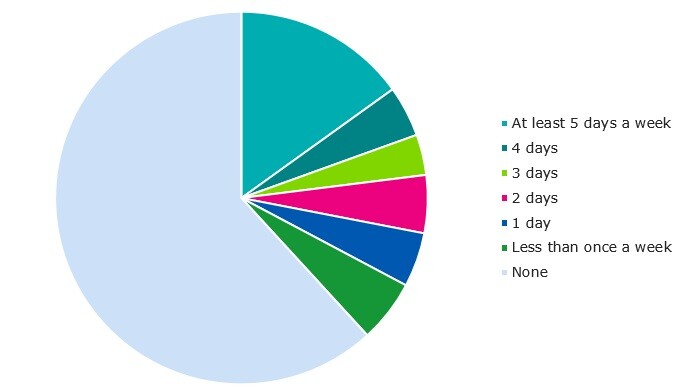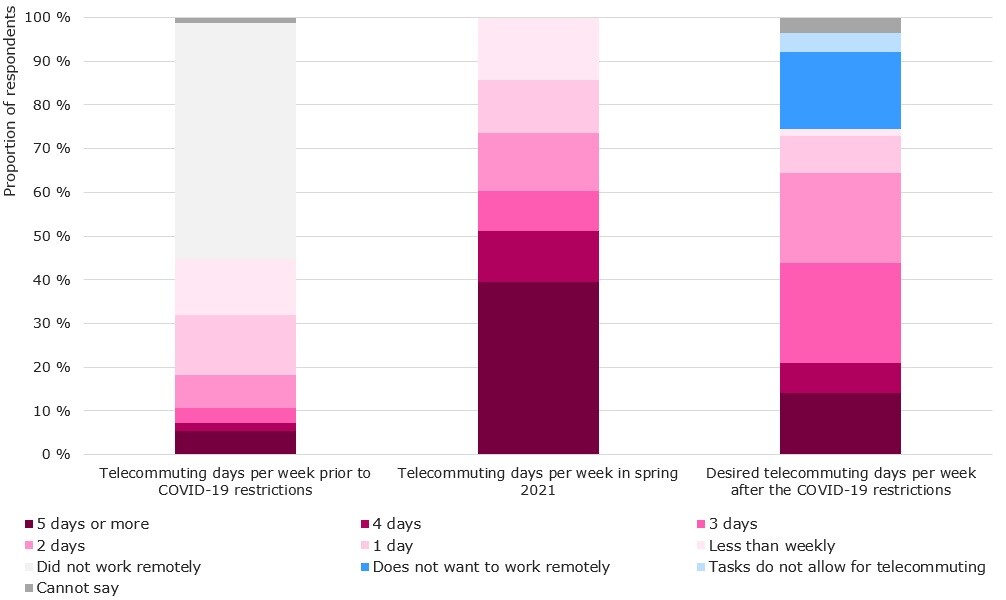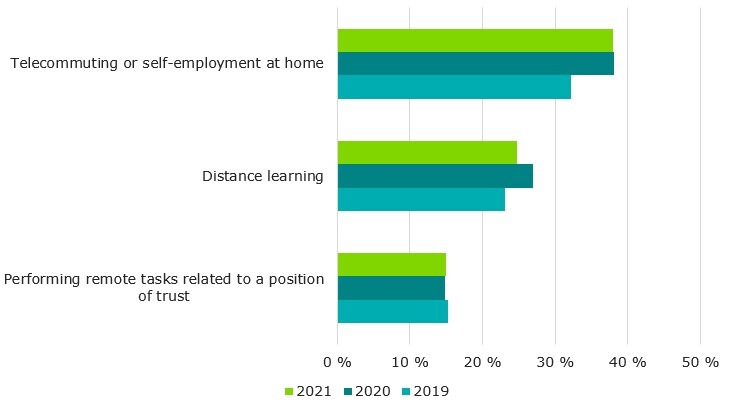According to the annual consumer survey by the Finnish Transport and Communications Agency Traficom on the use of communications networks and services, restrictions put in place to curb the COVID-19 pandemic increased the amount of remote work performed each week, and even after the pandemic, people want to continue working more from home compared to pre-pandemic times. However, a significant share of working-age people cannot telecommute due to the nature of their tasks.
The COVID-19 pandemic has made continuous telecommuting part of everyday life for many people. The increase in the amount of remote work due to the COVID-19 restrictions and what this way of working independently from time and place will look like in the future have been subjects of plenty of public discussion. Each year, we conduct a consumer survey on the use of communications networks and services, which we use to identify emerging consumer phenomena and gain a better understanding of the changes occurring in the communications market. The consumer survey conducted in spring 2021 focused on the telecommuting phenomenon in addition to conventional themes.
Most cannot work from home
Responses to questions concerning the amount of remote work are processed for respondents over the age of 25 but under the age of 65 in order to minimise any response bias caused by retirement or studies. In the interest of clarity, this group of respondents is referred to as working-age people.
In spring 2021, 15% of working-age consumers telecommuted on at least five days a week, meaning they worked remotely for the entire work week. A third worked remotely on at least one day per week. A clear majority of working-age people, 62%, did not telecommute at all in the spring of this year.

Out of those that did not work remotely at all, 68% said that their tasks could not be performed remotely. The second most common reason for not working from home was that the respondent was not working during the time under review. Only a few per cent reported that they did not want to telecommute and a group of a similar size reported that their employer did not allow remote work, even if it was possible due to the nature of their tasks.
Telecommuting attractive going forward, but not full time
The number of telecommuting days had increased significantly due to COVID-19 restrictions among those working-age people that worked remotely in spring 2021. In the spring of this year, 40% of those working remotely telecommuted on at least five days a week, i.e. full time. In contrast, only 5% of them worked as much remotely prior to March 2020. More than half of those working remotely now, 54%, did not work remotely at all prior to the pandemic.
Many of those now telecommuting were willing to continue working remotely even after the COVID-19 restrictions are lifted. People clearly wanted to increase the number of telecommuting days compared to pre-pandemic times, but most would like to work remotely less than they have been during the pandemic restrictions. For example, only 14% wanted to work remotely at least five days a week going forward.
On the other hand, 18% have had enough of telecommuting during the pandemic and would not like to work remotely at all in the future. Some of the people working remotely in spring 2021 will have tasks that do not necessarily allow them to telecommute in the future. These include upper secondary education teachers.

Please note in interpreting Figure 2 that the proportions reflect those 25–64-year-old respondents that worked remotely in spring 2021. Most in this age group did not telecommute at all during the time under review.
The home network connection is required for work and studies
In recent years, the Traficom communications consumer survey has included questions about telecommuting from the point of view of broadband connections. Some are able to work remotely even without an internet connection, even though this scenario is probably quite rare.
According to the consumer survey, 55% of all consumers needed an internet connection at home in spring 2021 weekly for work, self-employment, studies or performing tasks related to a position of trust. Thirty-eight per cent of consumers needed an internet connection for work and 25% for studies. These proportions have not increased significantly in recent years, but as can be stated based on the above, the amount of remote work has increased for those who are able to telecommute and may have done so previously.

The consumer survey was carried out by IROResearch Oy. The survey involved interviews with 2,001 Finns over the age of 15. The interviews were conducted over the telephone in March to May 2021.
The other sections of the consumer survey will be reviewed in future publications.
Additional information
Marja Heinonen, Communications Market Specialist, tel. +358 (0)29 539 0306, marja.heinonen@traficom.fi
The table of survey results and time series (External link) of the communications services’ consumer survey 2021
Traficom news article April 20, 2021: Reliable network connections a requirement for smooth telecommuting – the importance of broadband network development set to increase in the future